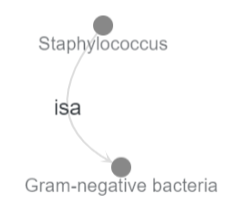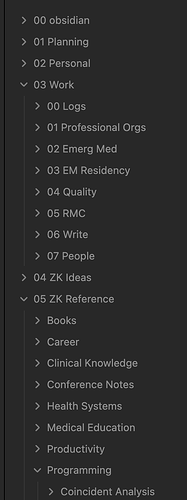I’m a family med physician, in the clinic full time. I’ve been using Obsidian for about 6 months and was using Ryder Carroll’s bullet journal system since 2018 before that. In the beginning, I basically did everything bullet journal style, but have slowly incorporated a more traditional zettelkasten approach. Keeping notes atomic has been key.
I still bullet journal:
Daily notes - my catch all. I put Fleeting notes in here, as well as my evening reflection. I use inline syntax like
Gratitude:: my new mouse is helping my carpal tunnel!
I also have yaml front matter that I use to monitor things like meds, hours slept, alcohol intake, etc.
Weekly/monthly notes - this is mostly dataview queries where I can visualize trends, review any open tasks, and read a summary of my logs. I have a gratitude log, a list of my daughters firsts, and funny things that happen at work.
Zettelkasten
Here’s where I keep things atomic. If I have no time to elaborate, I’ll write a thought down in my daily note using my zfleet:: shortcut. (ex. zfleet:: Andre 3000 and Rick Rubin podcast discuss social anxiety.) If I have time to elaborate, then I’ll make literature note. I make a conscious effort to prioritize writing it down. I’ve written paragraphs in my daily note before, then just cutting and pasting into a literature note later.
Literature notes - when there is an article or video that interests me, I write a literature note of why it struck a cord with me. I write it in my words as if I’m teaching it to myself 10 years later. (you bet your ass I have a lit note on the andre 3000/rick rubin podcast).
I also write lit notes on interesting case studies. Interesting presentations, side effects, cases where in stumped, etc I’ve seen in clinic.
I have “people” notes. I’m not sure where this fits. But if I hear Dr. X will see a patient for Y, then Dr. X will have their own note, basically like a rolodex. It’s helped a few times now. I had a 17yo who asked who in town they can talk to for a breast reduction, and I had a note saying Dr. X sees minors for breast reduction. It had all the necessary contact info, so I copied and pasted it into their after visit summary.
Permanent notes - this is the best part. These are my ideas that I’ve put together. There’s no end in sight. For example, from the rick rubin podcast, I’ve added onto my notes about social anxiety. I also created a new one about how Andre 3000’s creative rut stems from his fear of failure and tainting his legacy. This led to unexpected places like parenting advice (giving positive feedback regarding characteristics (so smar!) vs accomplishments (so hardworking!) ), and adhd management (when it’s ok to let your brain be unproductive on purpose).

